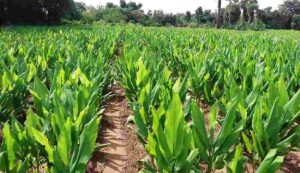Organic Farming of Turmeric: Organic farming of turmeric will give huge profits, know the process of cultivation
Organic Farming of Turmeric: Growing turmeric, also referred to as Indian saffron, may help farmers make enormous earnings. It is in high demand all year round since it is an essential component of Indian cooking. Because of its therapeutic qualities, it is also well-liked around the world. Growing turmeric organically has many advantages for farmers, including being beneficial for the environment and potentially lucrative.

Organic farming is a sustainable and eco-friendly practice. This agricultural practice does not utilize chemical pesticides or fertilizers.
Remember these factors while growing turmeric organically
1. Climate and soil preparation
For growing turmeric, choose loamy or sandy loam soil that drains well. The soil’s pH should be between 5.5 and 7.5 for this.
2. The weather
It needs a temperature between 20 and 30 degrees Celsius. To improve soil fertility, use organic manure such as vermicompost, neem cake, and cow dung manure.
3. Choosing Turmeric Light Bulbs
Always choose turmeric bulbs that are organic, disease-free, and healthy. Medium-sized bulbs with two to three eyes (buds) are ideal. Before planting, treat the bulbs with organic fungicide or cow urine.
4. Get the field ready
Add organic manure to the fields after they have been plowed. Then, at a spacing of 30 to 45 cm, construct a ridge. The fields should have an adequate drainage system.
5. Time to sow
Turmeric is planted in India from May to June. Plants should be 15–20 cm apart, and rows should be 30–45 cm apart. Plant the bulbs five to seven centimeters deep. One hectare of land needs 20–25 quintals of bulbs.
6. Time spent on irrigation
Moisture is necessary for the turmeric crop. throughout the monsoon season, no extra watering is required; however, throughout the dry season, light irrigation should be done every seven to ten days. For irrigation, use drip technology.
Take particular note of these things:
1. 30 to 60 days after seeding, do some mild weeding to get rid of weeds.
2. Timely treatment of pests and diseases may boost production.
3. Use crop rotation, growing other crops following turmeric, such as moong or gram.
4. It takes 7-9 months for turmeric to mature. When the leaves begin to dry up and turn yellow, harvest them.

